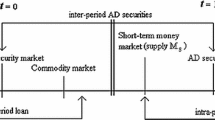Abstract
In a dynamic economy, money provides liquidity as a medium of exchange. A central bank that sets the nominal rate of interest and distributes its profit to shareholders as dividends is traded in the asset market. A nominal rates of interest that tend to zero, but do not vanish, eliminate equilibrium allocations that do not converge to a Pareto optimal allocation.
We want to thank Jean-Jacques Herings, Felix Kubler and Yannis Vailakis and the Hotel of Gianicolo for hospitality.
Access this chapter
Tax calculation will be finalised at checkout
Purchases are for personal use only
Similar content being viewed by others
Notes
- 1.
Search theoretic models of monetary economies (Diamond 1984) or (Kiyotaki and Wright 1969) are, evidently, more satisfactory, but the simple cash-in-advance formulation here, as in much of the literature, offers analytical tractability and does not play an otherwise important role in the argument argument.
- 2.
- 3.
Minor changes of notation from the abstract argument that follows facilitate the exposition.
- 4.
\( x^- i \) is the negative part of x.
- 5.
The set of all real valued maps on \(\mathcal {L}\) is \(\varvec{L}=\mathbb {R}^\mathcal {L}\). An element \(\varvec{x}\) of \(\varvec{L}\) is said to be positive if \(\varvec{x}\left( l\right) \ge 0\) for every l in \(\mathcal {L}\); negligible if \(\varvec{x}\left( l\right) = 0\) for all but finitely many l in \(\mathcal {L}\). For an element \(\varvec{x}\) of \(\varvec{L}\), \(\varvec{x}^+\) and \(\varvec{x}^-\) are, respectively, its positive part and its negative part, so that \(\varvec{x}=\varvec{x}^+-\varvec{x}^-\) and \(\left| \varvec{x}\right| =\varvec{x}^++\varvec{x}^-\). The positive cone, \(\varvec{L}^+\), of \(\varvec{L}\) consists of all positive elements of \(\varvec{L}\). Also, \(\varvec{L}_0\) is the vector space consisting of all negligible elements of \(\varvec{L}\). Finally, for every element \(\varvec{x}\) of \(\varvec{L}\),
$$\varvec{L}\left( \varvec{x}\right) =\left\{ \varvec{v}\in \varvec{L}: \left| \varvec{v}\right| \le \lambda \left| \varvec{x}\right| , \text{ for } \text{ some } \lambda >0\right\} $$is a principal ideal of \(\varvec{L}\). Unless otherwise stated, every topological property on \(\varvec{L}\) refers to the traditional product topology. We remark that, throughout the paper, the term ‘positive’ is used to mean ‘greater than or equal to zero’.
- 6.
As the allocation is Malinvaud efficient, it is Pareto efficient within every generation. As the allocation is individually rational and preferences are strictly monotone, if positive net trades vanish within a generation, so do negative net trades. Thus, using the fact that all generations are identical, \(\epsilon >0\) above does not exist only if no-trade is a Pareto efficient allocation within a typical generation. This does not occur generically in preferences and endowments.
- 7.
As far as individuals and commodities are concerned, notation is as in Sect. 15.3. In particular, an element \(\varvec{x}\) of \(\varvec{L}=\mathbb {R}^{\mathcal {T}\times \mathcal {N}}\) decomposes, across periods of trade, as
$$\begin{aligned} \varvec{x}=\left( x_0,\ldots ,x_{t-1},x_t,x_{t+1},\ldots \right) , \end{aligned}$$where each \(x_t\) is an element of \(\mathbb {R}^{\mathcal {N}}\); an element \(\varvec{x}\) of \(\varvec{E}=\mathbb {R}^{\mathcal {T}}\) decomposes, across periods of trade, as
$$\begin{aligned} \varvec{x}=\left( x_0,\ldots ,x_{t-1},x_t,x_{t+1},\ldots \right) , \end{aligned}$$where each \(x_t\) is an element of \(\mathbb {R}\).
- 8.
The discussion here is only suggestive, so that we avoid details on conditions for well-defined, though not finite, limits.
References
Bloise, G., & Polemarchakis, H. (2006). Monetary policy and dynamic efficiency in economies of overlapping generations. International Journal of Economic Theory, 2, 319–330. http://www.polemarchakis.org/a70-ogr.pdf.
Bloise, G., Drèze, J. H., & Polemarchakis, H. (2005). Monetary equilibria over and infinite horizon. Economic Theory, 25, 51–74. http://www.polemarchakis.org/a65-mei.pdf.
Clower, R. (1967). A reconsideration of the microfoundations of monetary theory. Western Economic Journal, 6, 1–8.
Diamond, P. A. (1984). Money in search equilibrium. Econometrica, 52, 1–20.
Drèze, J. H., & Polemarchakis, H. (2000). Monetary equilibria. In G. Debreu, W. Neufeind, & W. Trockel (Eds.), Economic essays: A Festschrift in honor of W. Hildenbrand (pp. 83–108). Springer. http://www.polemarchakis.org/o15-meq.pdf.
Friedman, M. (1969). The optimum quantity of money. In M. Friedman (Ed.), The optimum quantity of money and other essays (pp. 1–50). Aldine.
Gale, D. (1973). Pure exchange equilibrium of dynamic economic models. Journal of Economic Theory, 6, 12–36.
Hahn, F. H. (1965). On some problems in proving the existence of an equilibrium in a monetary economy. In F. H. Hahn, & F. P. R. Brechling (Eds.), The theory of interest rates (pp. 126–135). Macmillan.
Kiyotaki, N., & Wright, R. (1989). On money as a medium of exchange. Journal of Political Economy, 97, 927–954.
Lucas, R. E., & Stokey, N. L. (1987). Money and rates of interest in a cash-in-advance economy. Econometrica, 55, 491–513.
Nakajima, T. & Polemarchakis, H. (2005). Money and prices under uncertainty. Review of Economic Studies, 72, 223–246. http://www.polemarchakis.org/a64-mpu.pdf.
Samuelson, P. A. (1958). An exact consumption-loan model of interest with or without the contrivance of money. Journal of Economic Theory, 66, 467–482.
Santos, M. S., & Woodford, M. (1997). Asset pricing bubbles. Econometrica, 65, 19–57.
Weiss, L. (1980). The effects of money supply on economic welfare in the steady state. Econometrica, 48, 565–576.
Wilson, C. (1981). Equilibrium in dynamic models with an infinity of agents. Journal of Economic Theory, 24, 95–111.
Author information
Authors and Affiliations
Corresponding author
Editor information
Editors and Affiliations
Rights and permissions
Copyright information
© 2017 Springer International Publishing AG
About this chapter
Cite this chapter
Bloise, G., Polemarchakis, H. (2017). An Argument for Positive Nominal Interest. In: Nishimura, K., Venditti, A., Yannelis, N. (eds) Sunspots and Non-Linear Dynamics. Studies in Economic Theory, vol 31. Springer, Cham. https://doi.org/10.1007/978-3-319-44076-7_15
Download citation
DOI: https://doi.org/10.1007/978-3-319-44076-7_15
Published:
Publisher Name: Springer, Cham
Print ISBN: 978-3-319-44074-3
Online ISBN: 978-3-319-44076-7
eBook Packages: Economics and FinanceEconomics and Finance (R0)




